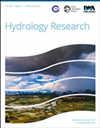Global hydrological parameter estimates to local applications: influence of forcing and catchment properties
IF 2.4
4区 环境科学与生态学
Q2 Environmental Science
引用次数: 1
Abstract
Data scarcity in many areas around the world represents a major problem for hydrological model calibrations. Global parameter estimates and global forcing can provide possibilities to access hydrological responses in ungauged regions. In this study, we applied HBV global parameter estimates considering uncertainty in the Upper Neckar and Upper Danube catchments, Germany to answer what are the influencing factors and how good are their local applications. We tested simulations with precipitation in spatial resolutions from 0.05° to 0.2° and with local/global sources. Results show that the general performance is acceptable to good (Kling-Gupta efficiency, KGE: 0.51–0.79) in both catchments using local or global precipitation. The influence of spatial resolutions is insignificant while using local precipitation slightly increases performance in both catchments. Catchment properties such as complex topography and special karst subsurface may lead to a deterioration of performance by 0.2 of median KGE in the Upper Danube compared with the Upper Neckar catchment. The median correlation coefficient, runoff ratio and relative error suggest that using global parameter estimates can reproduce seasonality and long-term water balance in our studied region. Our study highlights the potential of using global parameter estimates and global forcing in ungauged areas.对当地应用的全球水文参数估计:强迫和集水区特性的影响
世界上许多地区的数据短缺是水文模型校准的一个主要问题。全球参数估计和全球强迫可以提供获取未测量区域水文响应的可能性。在这项研究中,我们应用了考虑德国内卡河上游和多瑙河上游流域不确定性的HBV全球参数估计,以回答影响因素是什么以及它们在当地的应用有多好。我们测试了空间分辨率为0.05°至0.2°的降水模拟,并使用了本地/全球源。结果表明,在利用局地降水和全球降水的两种流域中,克林-古普塔效率(KGE: 0.51 ~ 0.79)总体表现尚可。空间分辨率的影响不显著,而利用局地降水可以略微提高两个流域的性能。多瑙河上游复杂的地形和特殊的岩溶地下特征可能导致该流域性能比内卡河上游下降0.2个KGE中值。中位数相关系数、径流比和相对误差表明,利用全球参数估算可以再现研究区域的季节性和长期水平衡。我们的研究强调了在未测量地区使用全球参数估计和全球强迫的潜力。
本文章由计算机程序翻译,如有差异,请以英文原文为准。
求助全文
约1分钟内获得全文
求助全文
来源期刊

Hydrology Research
Environmental Science-Water Science and Technology
CiteScore
5.30
自引率
7.40%
发文量
70
审稿时长
17 weeks
期刊介绍:
Hydrology Research provides international coverage on all aspects of hydrology in its widest sense, and welcomes the submission of papers from across the subject. While emphasis is placed on studies of the hydrological cycle, the Journal also covers the physics and chemistry of water. Hydrology Research is intended to be a link between basic hydrological research and the practical application of scientific results within the broad field of water management.
 求助内容:
求助内容: 应助结果提醒方式:
应助结果提醒方式:


